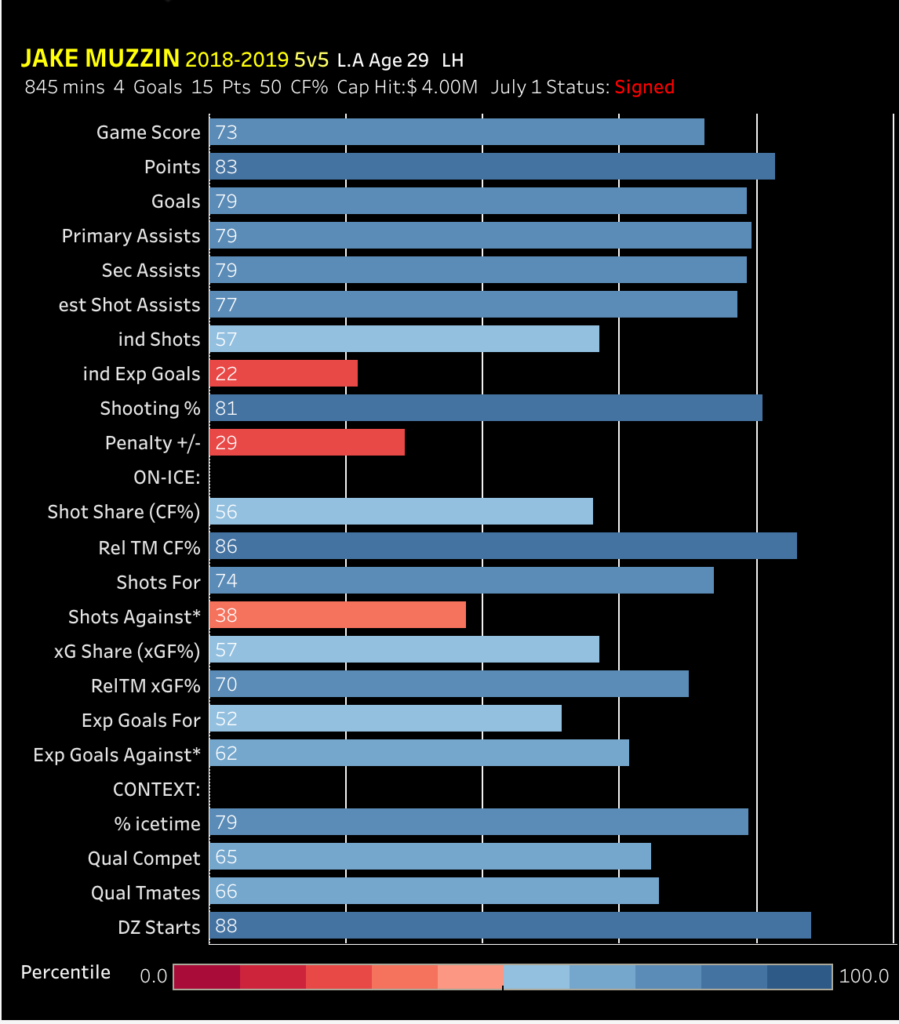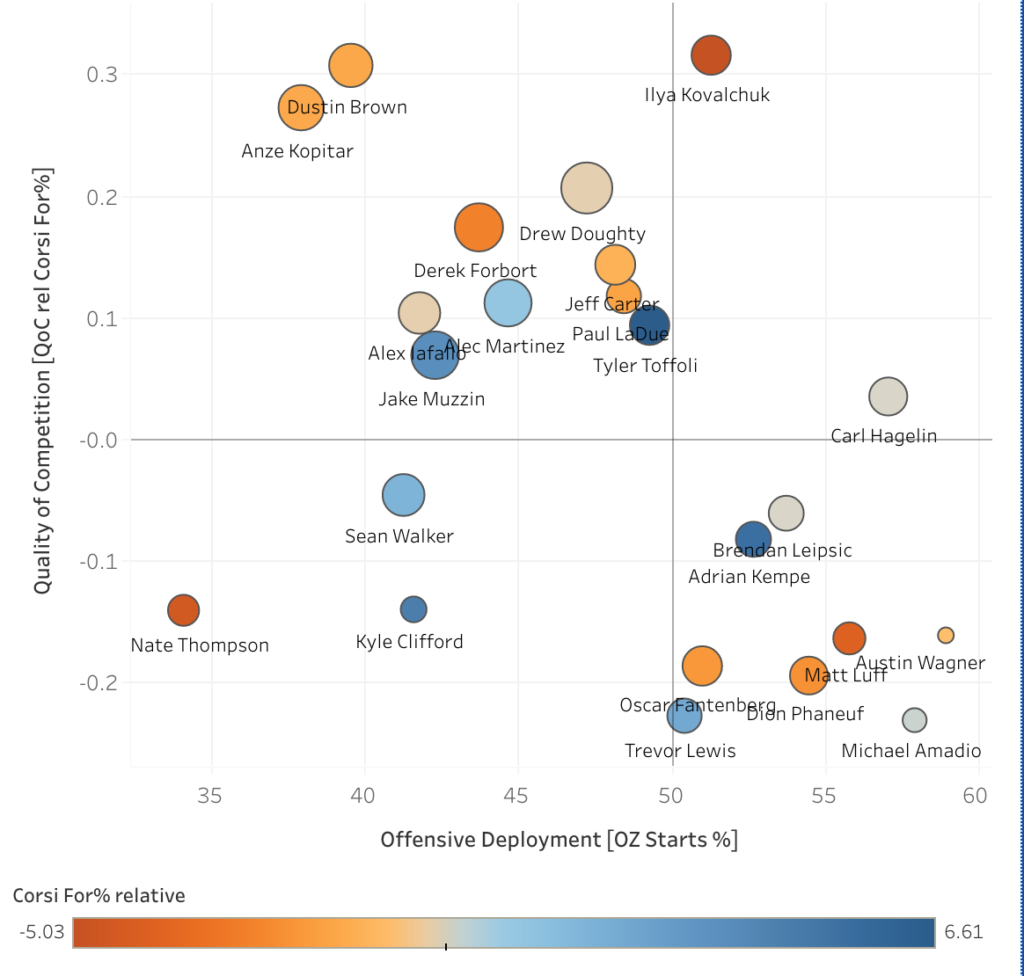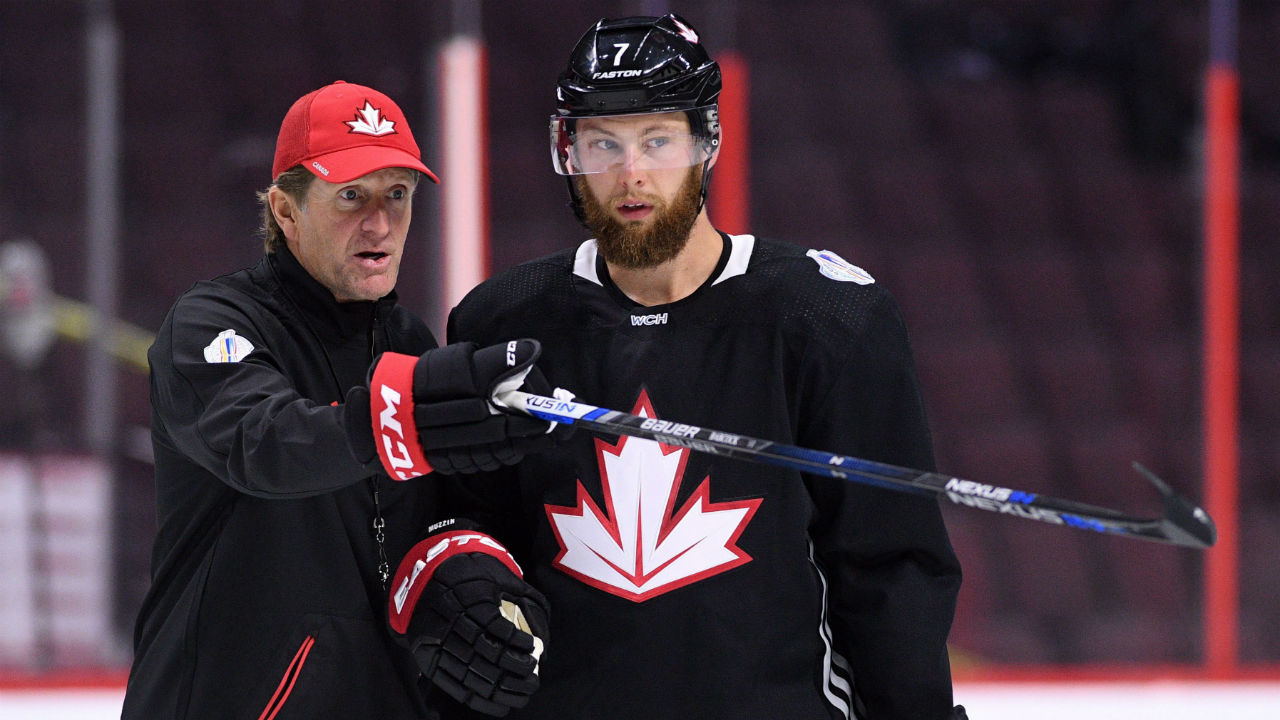Well, one day after writing about the Toronto Maple Leafs’ need on defense, they went out and actually acquired a legitimately good defenseman in Jake Muzzin.
The official trade sees the Leafs acquire Jake Muzzin in exchange for Carl Grundstrom, Sean Durzi, and the team’s 2019 first-round pick.
Muzzin turns 30 on February 21 and is signed through to the end of the 2019-20 season with a $4 million cap hit.
It’s the first notable trade of the Kyle Dubas era, and to his credit, he took a swing at trying to fill what is/was a rather obvious need.
The Player
This is the first season that Jake Muzzin has actually been under a 52.2 CF% in his career (which was his mark last season) as he has played on a Kings team that is about to go through a substantial overhaul. In every season of his career, he has posted a positive Corsi relative to his teammates. Overall, his underlying numbers paint the picture of a solid player:

His defensive ability is going to help the Leafs, but Muzzin is a legitimate puck mover who can break the puck out and make strong reads.
In three of his last four seasons, he has surpassed 40+ points and he currently has 21 in 50 games this seasons. He’s productive in part thanks to a heavy slapshot – his 23 taken this season is eight more than the highest Leaf (Ron Hainsey). Last season, his four slap shot goals would have led the Leafs (Patrick Marleau led with three). Right off the top, he adds a point shot that teams have to respect — a welcomed dynamic with opposing teams collapsing on the slot in the past few months against the Leafs because they didn’t have any sort of shot at the top of the blue line.
Over his last four seasons, Muzzin has put up between 10 and 14 power play points in all of them. You can now legitimately make the case to use two defensemen on the Leafs’ second unit. In any sort of tight game where they don’t feel comfortable running a forward on defense, they now have another option who is a defenseman to consider putting out.
On the defensive end, in his player usage chart, he shows as a dependable, two-way player who knows how to play in his own end with tough defensive zone starts versus tough competition:

Muzzin uses his size (he’s 6’3) and reach to clog lanes well and he adds a physical component to a team that has been soft in its own end for years (note: one player can’t fix this). The forward he has played the most against over the last three seasons is Connor McDavid, followed by a collection of his linemates in Milan Lucic, Leon Draisaitl and Ryan Nugent-Hopkins, followed by San Jose’s top players in Joe Thornton, Joe Pavelski, and Logan Couture.
In a nutshell, Muzzin gives the Leafs a third productive defenseman but he can also play defense and has done so against top players throughout his career.
The Trade Value
Generally speaking, it is difficult to acquire a legitimate top-four defenseman in the middle of a season. Over the past few seasons, here are some of the more notable relevant transactions:
- 2018: Tampa Bay Lightning traded Vladislav Namestnikov, Brett Howden, Libor Hajek, 2018 1st-round pick, Conditional 2nd-round pick for Ryan McDonagh and JT Miller.
- 2017: Washington Capitals traded a 2017 first-round pick; 2019 conditional second-round pick; LW Zach Sanford; LW Brad Malone for Kevin Shattenkirk and Pheonix Copley.
- 2017: New York Rangers traded a 2017 third round pick and 2018 second round pick for Brendan Smith.
- 2016: Kris Russell for Jyrki Jokipakka, Brett Pollock, Conditional 2016 2nd Round Pick
- 2015: Tampa Bay traded Radko Gudas, 2015 first round pick, 2015 third round pick for Braydon Coburn.
It is important to note that McDonagh was also not a rental; otherwise, all of the other defensemen were. Every trade includes a draft pick, so the Leafs trading a first as part of a package to acquire a top-four defenseman was not a surprise. In the Leafs’ case, with Sean Durzi only just drafted and his stock not particularly rising or decreasing since, it can be viewed as a first, a second, and a B-level prospect as Carl Grundstrom is now in his 20s.
Grundstrom had a good training camp last season and made an impression, but he didn’t show nearly as well this past camp. He does play the type of game that the Leafs generally lack and he has had a strong start to his AHL rookie season with 29 points in 42 games. He’s not a high-end prospect, but he’s a legitimate B-level prospect with signs pointing towards an NHL career of sorts.
All of this is to say: The Leafs didn’t trade a single asset that has played even one NHL game and they acquired a real top-four defenseman with term left on his deal and a manageable cap hit.
Looking at the history of these trades, there’s no argument to be considered that the Leafs overpaid. Short of Muzzin not being a fit (and it’s possible; more on that below), it’s hard to see the Leafs not benefitting from this as they have a team good enough to justify selling future pieces to try to win in the next two years.
Not only did the team manage to keep all their NHL players and add to the lineup, they also didn’t trade their top prospects – namely Rasmus Sandin and Timothy Liljegren. As Frank Seravalli noted, the team wasn’t willing to trade an Andreas Johnsson or Kasperi Kapanen for that right-handed defenseman, so this was the next best option at this point in time.
Some wondering why #Leafs got another left-shot D in Muzzin. Acquisition cost for RD is higher and other teams who have RD they could've dealt (#Canes) certainly aren't in same position as #LAKings where they could take back only futures.
— Frank Seravalli (@frank_seravalli) January 29, 2019
The Fit
Jake Muzzin’s primary partner over the last three seasons has been Alec Martinez, who has primarily been the left-handed player on his off-side, not Muzzin. If there’s one thing that gives pause about the trade, it’s how the pairings will shake out due to handedness.
Rielly has played the right, but it would be difficult to argue against him playing better and being more comfortable on his strong side. He’s also in the midst of a breakout career year. How do you interrupt that?
Jake Gardiner has primarily played the left side in his career and Travis Dermott is also a lefty, although he arguably has the most experience on the right side in his pro career (albeit at the AHL level).
To start, the expectation is that Muzzin will pair with Rielly and probably shift to the right side (where his one-timer could benefit on occasion). For Rielly, these are the partners he has played with the most at 5v5 for each season of his career:
| Season | Partner |
|---|---|
| 2013-14 | Jake Gardiner |
| 2014-15 | Roman Polak |
| 2015-16 | Matt Hunwick |
| 2016-17 | Nikita Zaitsev |
| 2017-18 | Ron Hainsey |
| 2018-19 | *Ron Hainsey |
Without question, Muzzin at the tail-end of his prime is the best partner Rielly will have had (note: in the Gardiner season, Rielly played nearly as much with Cody Franson and Tim Gleason… and also Paul Ranger; there was a lot of mixing and matching that year).
Muzzin is everything fans wanted Hainsey to be – a steady veteran who is big and physical and can contribute offensively but is also eight years younger. Naturally, it pushes everyone down a spot, but it’s difficult to see the team breaking up Gardiner and Zaitsev given they have been serviceable, and it would be strange to sit the promising Travis Dermott or to even ask Hainsey to suddenly switch sides. Plus, there is a benefit there for Dermott to be learning from a veteran. Suddenly, the Leafs have a pretty reasonable defense on paper. The team will have 12 games to try it out before the trade deadline.
With one year still to go on Muzzin’s deal after this, I’d be remiss if I didn’t note that the writing appears to be on the wall for Jake Gardiner unless they can actually move Nikita Zaitsev. Next season, the Leafs will have Muzzin, Rielly, Dermott and potentially Calle Rosen, who by every indication deserves a long look next season, on the left. Locking in Gardiner long-term – to a deal that will surely be $6M+ – locks in the Leafs’ top four on defense for nearly $20 million.
If they really wanted to make the dollars work, they probably could, but in terms of succession planning and building with one eye on the present and the other on the future, the Leafs are much better positioned now to let Gardiner walk, give Dermott more responsibility, and bring Rosen along the way they have with Dermott this season.
Concluding Thoughts
I’ll keep this brief, in point form:
- I’m sure a bunch of teams wanted Kasperi Kapanen in return for whoever they are trading, and I think the Leafs will ultimately be proven right in keeping the emerging winger. His speed is a legitimate weapon and it changes games.
- If the Leafs wanted to make a huge swing, they still have their top prospects and a good, young roster player to dangle in Andreas Johnsson, should they so choose.
- The team still has seven draft picks this summer: a second, a third, their own fourth and the Blues fourth, a fifth, their seventh, and the Stars’ seventh.
- If they wanted to try it, the team is definitely well positioned to try running 11 forwards and 7 defensemen now.
- It should be interesting to see if/when Igor Ozhiganov plays. He has steadily improved, although he still gets burned by big gaffes. He is a pending restricted free agent at the end of the season.
- The Leafs can still look to add another defenseman and/or a depth forward, particularly a center (but it would be difficult to picture them trading yet another second-round draft pick for yet another fourth-line center).
- Overall, this is a good, ‘we’re-going-for-it-but-not-pushing-all-our-chips-in’ trade.

































